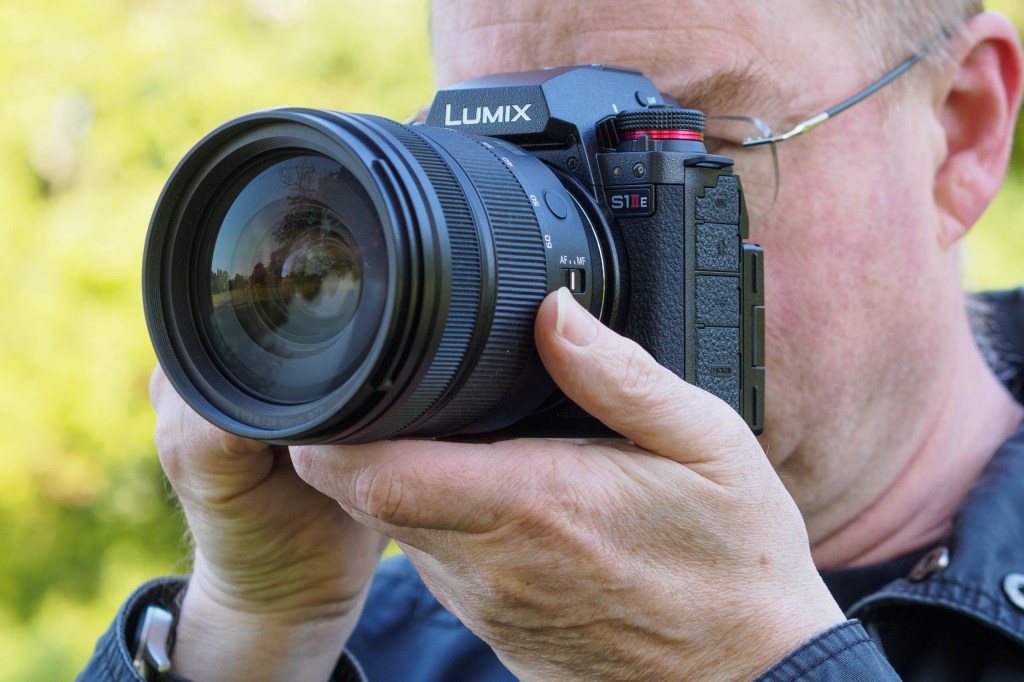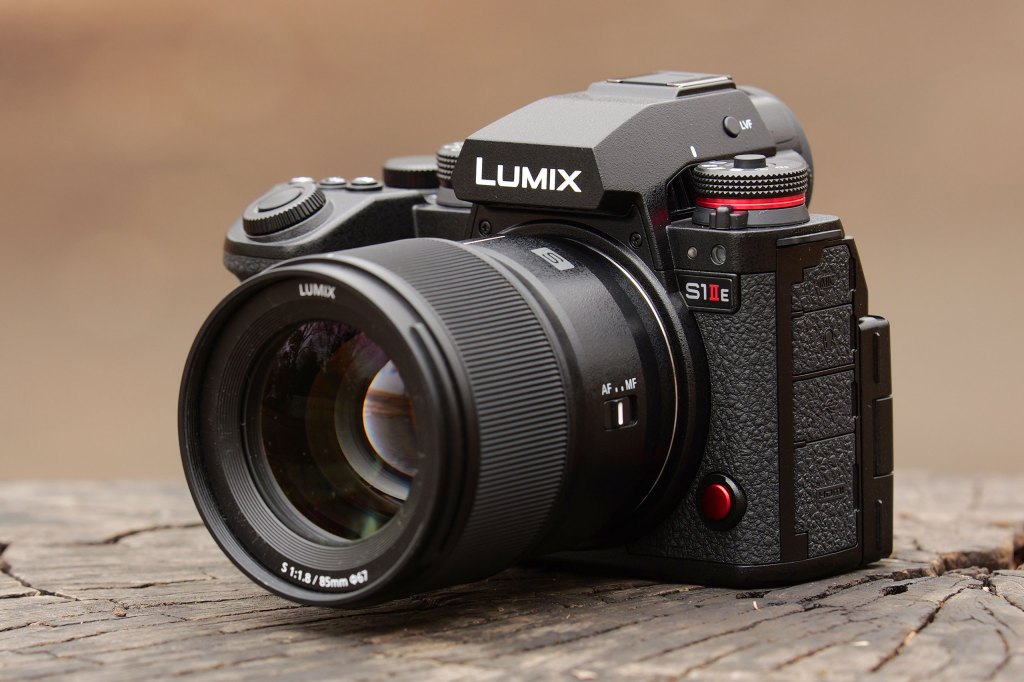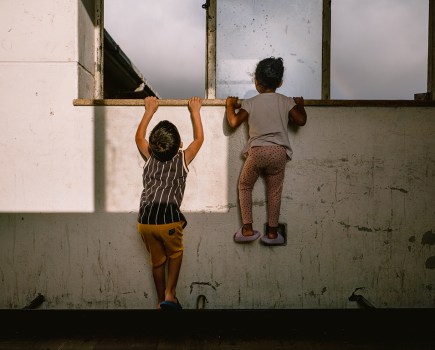Panasonic has introduced not just one, but two new 24MP models in its professional-oriented S1 range. Both the Panasonic Lumix S1II and S1IIE (E for “essentials”) share their body design with the high-resolution S1RII, with the nameplate being the only visible difference between the three cameras. However, the S1II has a ‘partially stacked sensor’ for high-speed shooting, while the S1IIE uses a conventional sensor at a rather lower price. Both cameras are due to go on sale in June.
Lumix S1II at a glance:
- £2899 body-only
- £3599 with 24-60mm lens
- 24MP partially stacked sensor
- Up to 70fps shooting
- 6K 60p, 4K 120p, Full HD 240p video
Looking first at the S1II, Panasonic says that it’s designed for professional photographers and videographers. Presumably, its partially stacked CMOS sensor is similar to that used by the Nikon Z6III. The advantage of this design is that, by bonding processing circuitry directly to the top and bottom of the chip, readout speeds can be dramatically improved, but without the same expense as a fully stacked sensor.
As a result, the S1II is the fastest full-frame camera that Panasonic has yet made. It can record 24MP stills at 70 frames per second, 5.9K video at 60fps, 4K at 120fps, and Full HD at 240fps. It also gains a new ‘open gate’ mode that records video from the entire sensor area in 5.1K and 60fps, alongside the existing 6K 30p option. This enables cropping footage to a variety of different aspect ratios in post-production.
The firm is promising its highest-ever dynamic range, too, of 15 stops in V-Log with Dynamic Range boost enabled, and at frame rates below 30p.
Lumix S1IIE at a glance:
- £2399 body-only
- £2999 with 24-60mm lens
- 24MP full-frame sensor
- Up to 30fps shooting
- 6K 30p, 4K 60p, Full HD 120p
Turning our attention to the S1IIE, Panasonic says that its sensor is similar to that in the older S5IIX. It’ll shoot 24MP stills at 30fps, 6K video at 30p, C4K 60p, and Full HD 120p. Dynamic range is specified as 14+ stops in V-Log. This all comes with a £600 saving over the S1II, meaning you can get the S1IIE with a nice lens for about the same price as its faster sibling.
Shared features
Both cameras include a number of new features compared to previous Lumix models. For example, there’s a new AF mode for ‘Urban Sports’ such as breakdancing, parkour and skateboarding. Although perhaps more usefully for most users, face and eye detection and tracking are also said to be improved.
Both models also gain a new 2.4:1 Cinemascope format. This is arguably more important on the S1IIE, as it enables 4K 60p recording using the full sensor width. That’s an advance over the S5IIX, which can only shoot 4K 60p in APS-C crop mode. For still images, the S1II and S1IIE become Panasonic’s first models to support HEIF format as a higher-quality alternative to JPEG.
Other key features include in-body image stabilisation which is rated for 8 stops of shake reduction when shooting hand-held. This is complemented by cropless electronic stabilisation mode for video. The cameras can record Apples ProRes RAW and ProRes RAW HQ internally to a CFexpress Type B card, at up to 5.8K 30p or C4K 60p.
Panasonic Lumix S1II and S1IIE: Familiar design
Both the S1II and S1IIE use exactly the same physical design as the S1RII – you can read our full Panasonic Lumix S1RII review here to find out more. In short, you get a chunky SLR-shaped body with an excellent control layout; a large, high-resolution viewfinder; and an extremely versatile rear screen that combines a side-hinged fully articulated mechanism with the ability to tilt up and down behind the body. It’s a really nice camera to use that’s a match for anything similar from other mainstream brands.
Unlike the firm’s cheaper 24MP S5II models, there’s one slot for UHS-II SD cards, and another for the faster CFexpress Type B media, which you’ll need to use for recording this highest quality video. A fan built into the viewfinder housing provides active cooling for extended video recording.
First impressions
With the S1II and S1IIE, Panasonic has moved into an extremely competitive area of the camera market. In particular, at £2399 body-only, the S1IIE starts out at about the same price as older but still very capable models including the Sony Alpha A7 IV, Canon EOS R6 Mark II, and Nikon Z6III, with the later providing particularly stiff competition. Meanwhile the S1II looks very expensive for a 24MP camera, at £2899, but uniquely it does combine a partially stacked sensor and high-end body design.

After handling both cameras, and in particular using the S1IIE for a couple of days before its launch, it’s a little difficult to know quite what to make of Panasonic’s thinking here. To me, the S1II makes sense within the context of a premium “1-series” – it’s the best 24MP camera Panasonic knows how to make. But the S1IIE is less easy to understand – essentially it feels like you’re spending a lot of money on a nice body design and viewfinder etc, at a price level where other manufacturers are placing more emphasis on the sensor and autofocus technology inside.
Don’t get me wrong, the S1IIE is a perfectly capable camera that’s enjoyable to use. I’m just not quite sure why both models need to exist, or whether Panasonic is offering sufficiently standout features at an attractive enough price to lure potential buyers away from Canon, Nikon or Sony. This stands in contrast to the S1RII, which unequivocally offers excellent value for money. I’ll examine this in more detail in our upcoming full reviews.
Follow AP on Facebook, X, Instagram, YouTube and TikTok.








